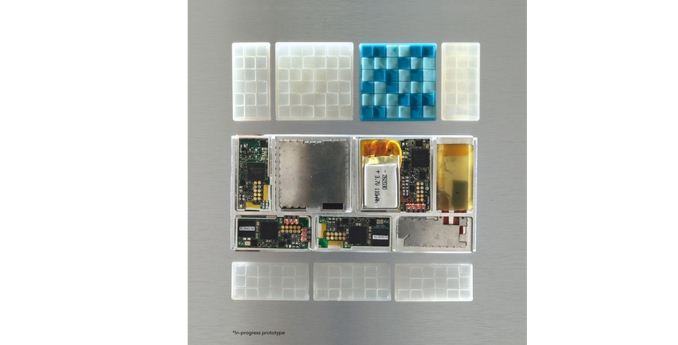Modular Smartphone Project Ara from Google to Start Development Conferences
by Ian Cutress on February 26, 2014 6:49 PM EST- Posted in
- Smartphones
- Mobile
- Project Ara
- Conferences

Joshua talked about Project Ara (from Motorola at the time) back in October as a campaign that focused on attracting OEM interest into a modular smartphone design. The results of that campaign take the next step forward as Google announces the first set of developer conferences for a modular device.
Headed under the Advanced Technology and Projects (ATAP) division, the platform is meant to be a single hub onto which the user can place their own hardware. This means CPUs, cameras, sensors, screens, baseband, modems, connectivity, storage – the whole gamut. The issue with such a device compounds the effects of going from a managed ecosystem (Apple and several hardware combinations) to a free ecosystem (Android and every hardware combination). Project Ara takes this complexity one stage further, and there has to be a fundamental software base to solve this. Hence ATAP is going to be doing three developers’ conferences in 2014, starting on April 15-16 at the Computer History Museum in Mountain View, California.
Aside from those attending in person, the event will be live webcast with question and answer sessions built into the programme. Due to the early stage of Project Ara, the initial conference is all about the modular system itself, building a device and getting it to work. Coinciding with the first conference, an alpha version of the Module Developers’ Kit should be available.
The other two conferences for 2014 are yet to be announced. Further info on the conference is found at the website projectara.com, to be updated over the next few weeks with more details.
To quote the website:
We plan a series of three Ara Developers’ Conferences throughout 2014. The first of these, scheduled for April 15-16, will focus on the alpha release of the Ara Module Developers’ Kit (MDK). The MDK is a free and open platform specification and reference implementation that contains everything you need to develop an Ara module. We expect that the MDK will be released online in early April.
The Developers’ Conference will consist of a detailed walk-through of existing and planned features of the Ara platform, a briefing and community feedback sessions on the alpha MDK, and an announcement of a series of prize challenges for module developers. The complete Developers’ Conference agenda will be out in the next few weeks.
This first version of the MDK relies on a prototype implementation of the Ara on-device network using the MIPI UniPro protocol implemented on FPGA and running over an LVDS physical layer. Subsequent versions will soon be built around a much more efficient and higher performance ASIC implementation of UniPro, running over a capacitive M-PHY physical layer.
The Developers’ Conference, as the name suggests, is a forum targeted at developers so priority for on-site attendance will reflect this. For others--non-developers and Ara enthusiasts--we welcome you to join us via the live webstream. That said, we invite developers of all shapes and sizes: from major OEMs to innovative component suppliers to startups and new entrants into the mobile space.











28 Comments
View All Comments
nerd1 - Thursday, February 27, 2014 - link
There already are enough wifi camera modules that can be used with smartphones, bunch of bluetooth keyboards, USB otg cables and micro sd slots. Samsung even provides micro usb to ethernet adapter for their pro tablet lineups.So everything you mentioned can be implemented as add-on accessories, and they already are.
ruthan - Thursday, February 27, 2014 - link
Modular laptops, arent here because anybody doesnt offer them. Because better business is sell you whole new laptop very year. But there lots of users whose would like to upgrade CPU or GPU in laptop.Yeah, closed phone would be probably everytime more effective for same money, if you will invest big budget, but after year or two, upgrade of CPU / GPU / Memory old modular phone could be better deal, in longterm.
I hope that also mainboard would be modular and changeable.
Conficio - Thursday, February 27, 2014 - link
It just struck me that the same concept could work nicely for automotive systems, where you have components in close proximity but not within a few inches.Like have a source of power, a screen in the console (or dashboard or heads up), mics and speakers in the right places, antennae in the optimal places, buttons on the steering wheel, ...
And ideally you could replace those components with improved one's over the long life span of the car.
ritabhatt - Thursday, February 27, 2014 - link
Which model is this https://www.youtube.com/watch?v=ZMU51KeRIcschizow - Friday, February 28, 2014 - link
Dear Google,Don't bother.
Thanks.
Daller - Friday, February 28, 2014 - link
All this modularity is stealing away precious space that could be used for a bigger battery. The one in the picture is a 3.7V 110mAh... pathetic!Unless they somehow solve this battery issue I believe these handsets will be too cumbersome for anyone to want to handle.
whatsa - Friday, February 28, 2014 - link
I see the idea but for a phone its too much...1or2 add ons maybe but thats it.
This is what Jolla has done with the smart cover(TOH) and i2c so the functionality can be added in a back cover. Really much more than one add-on is just a toy and probably not you daily driver.
anirudhgargi - Monday, March 3, 2014 - link
Adding a UNiPro over M-Phy for each module will deinately increase the cost as the IP for MPHY is very complex and i guess not cheap. Unless vendors come toagther and share stuff and reduce cost. At the same time i see advantage i see is inter-module interface can be easliy standarized , also M-PHY + Uni Pro has already proved to be very very fast and low latency in tune of hunderd nano sec.As for the concens of power, definnatly more power needed when signal travel across chips . Plus more interference(huge pain !).
Having a primary + secondary battery can be a quick solution, much like a external battery pack.
keeping display with some battery at it back.
For concerns of flashing, already many devices support flashless boot. Like modems chips in mobiles. Binary is loaded with every boot from main Processor with some falsh storage.
Similarly here each module can have support basic Boot-Rom with primary interface drivers to load binary in their RAM and work on. Or perhaps shared RAM across chips can be a novel idea. M-PHY over MIPI LLi has known to demonstrate such feats with latency less than of 90ns. No need to send binary or all, all module work in their own partitions of RAM !
Form Factor will be biggest challenge. Making it compact will be a later target. Even if the 'mobilty' is hampered, it can be great soltion.
And finally one can upgrade beyond 'storage' and 'software' on phones !